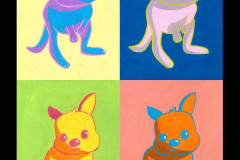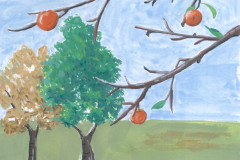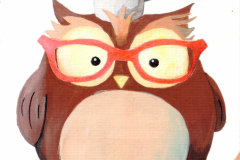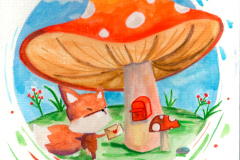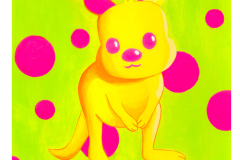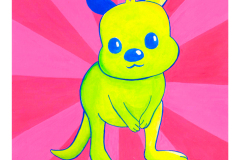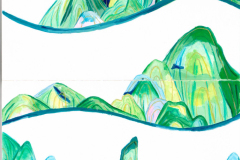Introduction
Abstract art stands out for its ability to convey feelings and ideas without using clear shapes or figures. Bold canvas art takes this concept further by using strong colors and forms that grab your attention immediately. Using gouache paint layers offers a unique way to achieve this effect. Gouache is a special paint that looks thick and vibrant on canvas. It covers well and can be used in many artistic ways. With gouache, your abstract art can have a rich texture and strong colors that make your painting lively and interesting. This article will guide you through how to use gouache layers to create bold, colorful, and eye-catching abstract canvas paintings.
By learning about gouache, you understand why artists choose it for creating abstract art. You will find ideas on how to mix and layer colors to bring depth to your work. The use of gouache layers can change the way your painting looks from flat to dynamic. This guide will help you develop your skills in using gouache and inspire you to try new styles of abstract painting. You will also find practical tips for preparing your canvas, working with paint layers, and finishing your artwork so it looks polished and professional.
Understanding Gouache Paints
Gouache paint is a water-based medium known for its thick, creamy consistency and solid, opaque finish. Unlike watercolor, which is transparent and delicate, gouache hides what lies beneath with strong pigment coverage. Acrylic paint also offers opacity but dries to a plastic-like surface, while gouache remains matte and smooth. This makes it ideal for bold abstract work where strong color blocks and layered textures matter.
You will notice gouache has a high pigment load. This means colors stay rich and vivid even after drying. Its drying speed tends to be faster than oil paints but slower than watercolor, giving you enough time to work and rework layers without losing brilliance. The combination of opacity, pigment concentration, and drying properties makes gouache a unique choice for striking abstract paintings on canvas.
What Makes Gouache Unique
Gouache stands out because of its body color, meaning it remains thick and solid when applied. This thickness allows the paint to cover surfaces fully, unlike watercolors, which soak in and fade. When you use gouache, layers appear flat and uniform, offering a clean edge that works well in abstract designs.
The paint also interacts with different surfaces in unexpected ways. On textured canvas, it can reveal the grain beneath while keeping strong coverage. This interaction lets you play with both smooth, bold shapes and subtle texture contrasts. If you want your abstract art to have depth and clarity, gouache will respond differently than other paints, letting you control your shapes and shades precisely.
Benefits of Using Gouache for Abstract Art
Gouache dries quickly, which allows you to add new layers without long waits. This speed helps maintain energy in your creative process. Its high pigment density means colors stay bright and don’t dull when spread thin or thick on the canvas.
You can layer gouache easily. Because it is opaque, one color won’t show through the layer on top. This makes correction and modification simple. If you want to change a section, you can paint over previous layers without them bleeding through or turning muddy.
Gouache retains some re-wettable quality, so you can soften edges or blend colors even after drying. This flexibility supports spontaneous adjustments and experimentation, essential for abstract art that thrives on bold, unexpected forms and vibrant colors.
Choosing the Right Canvas for Gouache
Your choice of canvas affects how gouache paint behaves and the overall look of your abstract art. Gouache is water-based and sits differently on canvas than acrylic or oil paint.
Consider the surface texture when selecting a canvas. Smooth canvases let gouache spread evenly, creating clean lines and flat areas of color. Rough canvases absorb more paint, giving a textured, grainy effect that may add depth but can make details harder to control.
Priming plays a key role too. Unprimed canvas soaks up water and pigment quickly, which can mute gouache’s bright colors. Using a good primer or gesso layer helps paint sit on top of the surface, preserving gouache’s opacity and vibrancy.
Different canvases produce different moods and finishes in abstract work. Have you tried pairing rough canvas with smooth gouache layers to see which you prefer? How does your canvas choice influence your layering and blending techniques?
Canvas Texture and Its Impact
Smooth canvas surfaces don’t soak up as much paint, allowing gouache to stay on top and keep colors intense. This works well if you want sharp shapes and bold flat zones of color.
Rough canvases absorb water faster and show more texture under paint. This can create effects that work for more spontaneous, tactile abstract styles. However, paint tends to dry quickly and unevenly, so you may need to adjust your brushstrokes.
Think about how the canvas texture interacts with your layering method. Does using a coarse canvas help your layers stand out, or does it cause colors to dull? Testing small samples on both smooth and rough canvases can guide your choice.
Preparing Canvas for Gouache
Preparing canvas ensures better paint adhesion and helps maintain gouache’s vibrant look. Start by applying one or two coats of acrylic gesso to seal the fabric and create a barrier against paint absorption.
Sand the dried gesso lightly to smooth the surface if you want fine detail or sharp edges. For bold abstract work, a slightly textured gesso layer can add interest and grip for the gouache.
Let each gesso layer dry completely before painting. If you skip priming, gouache may soak in and look dull. Taking these simple preparation steps gives you more control over your paint and final image.
Basic Gouache Painting Techniques
Working with gouache on canvas requires understanding how to control your paint and brushes to shape bold abstract forms. Focus on mastering brushwork to create distinct shapes and strokes that pop. Gouache dries quickly, so plan your steps for layering without muddying colors. You can use gouache’s opacity to block out or layer colors, making some parts stand out while others recede. Blending works best when your paint stays slightly wet; try soft edges by gently mixing colors on the canvas. Practice layering thin coats to build depth without overwhelming the surface. How will you balance vivid layers with subtle tones in your abstract painting? Think about how each layer communicates with the one below it and anticipate how drying affects your final look.
Brushwork Styles to Try
Brush strokes define the energy and movement in your abstract work. Experiment with flat brushes for broad, solid areas and round brushes for smooth, flowing lines. Dry brush strokes add texture and a sense of spontaneity by leaving gaps in the paint. Using quick, short flicks can create rhythm, while long, sweeping strokes express calm or tension. Try varying pressure to switch from thin to bold lines in one motion. Ask yourself which strokes convey the mood you want. Different brushes and stroke speeds shape the personality of your painting. Testing these on a practice canvas can help you find your unique abstract voice before committing to a final piece.
Layering and Blending Techniques
Build layers thoughtfully to keep gouache’s opacity intact and avoid dullness. Apply each layer only when the previous one dries completely to prevent colors from mixing unintentionally. Use thin layers to let underlying shapes or colors peek through, adding visual intrigue. Wet-into-wet blending works well for smooth transitions, but only if you act quickly before the paint sets. You can also layer contrasting solid colors for sharp edges that stand out boldly. Consider saving areas with masking tape or liquid frisket to protect details while layering. How will you manage your drying times and paint thickness to create vibrant abstract depth? Planning your layers unlocks the full potential of gouache on canvas.
Creating Depth With Gouache Layers
Using multiple gouache layers can bring impressive depth to your abstract canvas paintings. Decide which parts of your painting should stand out and which should recede. Start with broader, lighter shapes on the first layers. Then apply darker or more detailed layers on top. This approach creates a sense of space and movement.
Think about the order in which you apply layers. Let each layer dry fully before adding the next. This avoids mixing colors unintentionally, which can dull your tones. You might experiment with using semi-opaque layers to allow colors underneath to subtly shine through.
Consider how the colors interact as you layer. Placing bold cleancolors next to muted shades makes the vibrant areas pop forward. Explore how layering transparent and solid colors changes the mood and depth of your canvas. Ask yourself, which color combinations create a feeling of foreground and background?
Building Layers Properly
Apply gouache layers thinly and let each dry completely before adding the next. This prevents colors from blending into a muddy mess. Use a soft brush and working edges carefully helps maintain crisp lines between colors.
Avoid overworking an area. Constantly brushing wet paint can remove pigments and dull vibrancy. If you want to darken or add detail, wait for the existing layer to dry fully.
Start with lighter colors as a base and apply darker colors later. This way, you keep your painting dynamic and avoid losing bright hues under heavy paint. You can also use dry brush techniques on top layers to create texture without mixing colors.
Using Color to Enhance Depth
Contrast plays a big role in creating the illusion of depth. Use cool colors like blues or greens in the background layers and warm colors like reds or yellows toward the foreground. This shift makes areas feel closer or farther away.
Complementary colors, those opposite on the color wheel, can energize your painting when layered thoughtfully. For example, a layer of blue beneath an orange glaze gives both colors more punch.
Experiment with layering transparent colors over opaque ones. See how a thin crimson glaze over a yellow base can create a glowing effect. Ask yourself which color mixes deepen the structure of your composition.
Incorporating Bold Abstract Forms
Bold shapes create a strong visual anchor in your abstract paintings. Use gouache to build large, simple forms that catch the eye. Start with broad strokes and clear outlines to establish structure. Think about how your shapes interact on the canvas–overlapping or standing apart to create tension or balance. Keep your focus on the contrast between forms and the space around them.
Consider repeating shapes or varying their sizes to guide the viewer’s attention. The opacity of gouache lets you layer colors and shapes clearly, helping forms stay distinct. Ask yourself: Do the shapes feel deliberate? Do they command attention without clutter? Working with bold forms can make your abstract art feel purposeful and engaging.
Designing Strong Shapes
Start by sketching simple shapes that feel strong and clear. Use tools like charcoal or pencil to map the forms but avoid too much detail. Focus on geometric or organic shapes that contrast each other. Pick shapes that can fill or break your canvas space effectively.
Test different shapes by placing cutouts on your canvas. See which ones stand out and which get lost. Choose forms that feel confident even without color. For example, a large triangle next to a sweeping curve can create an exciting dynamic. Consider the energy each shape brings before you paint.
Painting with Confidence
Use steady, purposeful brushstrokes to build your forms. Let your hand move freely but with intent. Thick, even layers of gouache create solid shapes that won’t fade into the background. Select vibrant colors that contrast sharply with nearby areas to highlight your shapes.
Try limiting your palette to a few bold hues to keep the focus strong. Remember how confident brushwork can affect the mood. If you hesitate, your shapes might lose power. Ask, how does each stroke add strength? Practice making deliberate marks and see your forms grow bolder with every layer.
Adding Texture and Patterns
Using Gouache for Texture Effects
Gouache can do more than just lay flat color on your canvas. Using thicker layers brings out a tactile quality that invites closer look. Try loading your brush with gouache and pushing it onto the canvas with firm, uneven strokes. This builds raised patches that catch light differently.
Dry brushing offers another option. Dip a dry brush in a small amount of paint, then skim it lightly over rough or textured surfaces. This technique creates broken layers of color that add depth and interest.
Scraping is a technique where you use tools like a palette knife or even a credit card to remove or shape wet paint. You can reveal colors underneath or create sharp, deliberate marks contrasting with softer brushwork.
What kind of textures might you add to a bold abstract canvas to make it stand out? Experiment with these methods to give your painting a unique feel that draws the eye.
Incorporating Pattern Design
Patterns can work alongside texture to build visual complexity. Using gouache, you can paint simple shapes like dots, lines, or grids on top of or within your bold forms. These overlays break up solid areas and add rhythm.
Try repeating small motifs in uneven spacing to keep your composition spontaneous. Curved lines layered over angular shapes provide contrast. You might also weave thin zigzag patterns discreetly through your broader strokes to hint at movement.
Look for places where patterns and forms intersect. Can you combine sharp, blocky strokes with soft, organic marks to create tension? Including subtle patterning invites viewers to explore your abstract piece more deeply, revealing fresh details each time.
Which patterns respond well to the boldness of your gouache layers? Pick a few and see how they transform your canvas.
Correcting Mistakes and Adjusting Layers
Working with gouache on canvas gives you flexibility, but mistakes happen in any painting. Knowing how to fix errors or adjust layers carefully can save your work and improve your piece.
If a layer looks too dark or uneven, you can gently lift some paint by dampening a clean, soft brush or cloth with water and dabbing the area. This softens the paint without damaging the canvas. Remember to do this before the paint fully dries for easier removal.
When a shape or color needs changing, wait until the layer dries fully. Then, apply a thin, opaque layer of gouache over the area. Gouache’s opacity lets you cover errors without muddying colors underneath.
Have you noticed how some parts of your painting don’t blend well? You can skim lightly over edges with a damp brush to soften transitions. This helps corrections fit naturally without harsh lines.
Think about the layers you built. The strongest corrections work when you adjust layer thickness. Try painting over with thin layers and gradually build opacity. This way, your changes blend smoothly and keep the canvas texture visible.
Removing or Modifying Layers
You can lift off unwanted layers by using a wet brush gently on the painted area. Dab softly rather than scrubbing to avoid damaging the canvas surface. Sometimes blotting with a paper towel after wetting helps pull paint off cleanly.
If you want to add a new shape or color over a mistake, wait for the paint to dry completely. Use opaque gouache to cover the spot. Painting with lighter strokes keeps the layer from looking thick or raised.
For bigger corrections, try scraping lightly with a palette knife before layering again. This method can smooth out thick spots or texture issues from earlier paint layers without harming the canvas.
What have you tried before when altering layers? Experiment with different tools and strokes to find what works best for your style and the specific texture of your canvas.
Blending Corrections into Artwork
To help repairs look natural, soften edges of the correction by brushing a clean, slightly damp brush around them. This step reduces sharp contrasts between old and new paint.
Use colors from surrounding areas to mix with your correction. This creates gradual shifts and matches the overall palette. Adding slight touches of adjacent colors can hide changes.
Working in thin layers allows you to build a smooth transition between the correction and existing paint. Avoid applying thick paint quickly, which can make fixes stand out.
Have you tried glazing thin layers to blend changes? Mixing water and gouache creates translucent coats that gently adjust color or value without covering details beneath.
Paying close attention to light, shadow, and texture around the corrected area helps your changes blend seamlessly. Look closely and keep adjusting until your correction fits the artwork’s flow.
Finalizing and Protecting Your Abstract Gouache Painting
Sealing Your Canvas
Gouache is sensitive to moisture, so sealing your canvas is a key step to protect your work. Choose a fixative designed specifically for gouache or watercolor paints to avoid disturbing the colors or texture.
Spray the fixative evenly in thin layers, holding the can about 12 inches away from the canvas. Let each layer dry completely before applying the next. Test the fixative on a sample painting first to check for any changes in color or finish.
Avoid brushing varnish on gouache as it may rewet and smear the paint. Instead, opt for a spray varnish that offers UV protection and guards against dust. Applying a proper sealant extends the life of your painting, keeping the bold layers vibrant over time.
Have you noticed how sealed paintings maintain their freshness longer? Take this final care seriously—it preserves your creative efforts.
Choosing Frames and Display Options
Choosing the right frame helps display your abstract gouache painting beautifully while protecting it. A deep shadow box frame works well for canvases because it prevents the glass from touching the paint surface.
You can also select a simple wooden frame that complements the colors in your artwork without overpowering it. Consider using acid-free matting to keep the painting safe from environmental damage.
Mount your canvas securely with stretcher bars or clips designed for its size. Frames with UV-resistant glass or acrylic increase protection, especially if your painting will hang in sunlight.
Do you want the frame to be part of the artwork’s story? Match your frame style with the energy of your abstract layers—it can add depth to the viewer’s experience.
Framing wisely ensures your bold canvas stands out while lasting for years in galleries, homes, or shops.
Inspiration and Next Steps for Your Abstract Gouache Art
Sources of Inspiration
Look closely at artists who use gouache for abstract work, such as Henri Matisse or contemporary painters like Nina Katchadourian. Their use of color and shape might spark new ideas for your own pieces.
Consider art movements like Abstract Expressionism or Color Field Painting. Notice how they emphasize emotion through form and color instead of detail. How can you apply these concepts with your bold gouache layers?
Change your environment to refresh your creativity. Try painting outside or visit museums. Urban scenes and natural patterns often provide strong shapes and colors you can translate into your canvas.
Ask yourself: What textures or colors do I notice daily? How might they appear with gouache on a larger scale?
Expanding Techniques and Styles
Add other materials to gouache. Combine it with charcoal, ink, or collage elements to create unexpected textures and depth on canvas.
Use tools beyond brushes, like palette knives, sponges, or stencils. These can create sharp edges or soft blends, helping your layers stand out boldly.
Challenge yourself with bigger canvases. Larger surfaces let you work freely with your strokes and colors. How will your ideas change when scaled up?
Try altering thickness of your gouache layers. Thin washes can balance thick patches, creating tension and discovery within your painting.
What technique have you left unexplored recently? Invent your own process for layering gouache and watch your abstract art grow stronger.
Conclusions
Creating bold abstract paintings on canvas with gouache layers offers a way to express your creativity with strong colors and textures. You have learned how gouache paint works differently from other paints because of its thick, covering qualities. Using multiple layers helps add richness and interest to your artwork. The steps and ideas shared here can help you start or improve your abstract painting practice. Experimenting with different techniques will allow you to develop your own style and produce unique pieces that stand out.
Thinking about your purpose and feeling during painting can guide how you use gouache layers. The paints give you freedom to change and build your image until it feels right to you. Bold canvas art with gouache delivers striking results because of the way color and shape interact on the textured surface. You can use this method to make artwork that captures attention and reflects your personal vision. Keep experimenting and learning more about gouache to continue growing as an abstract artist.



















